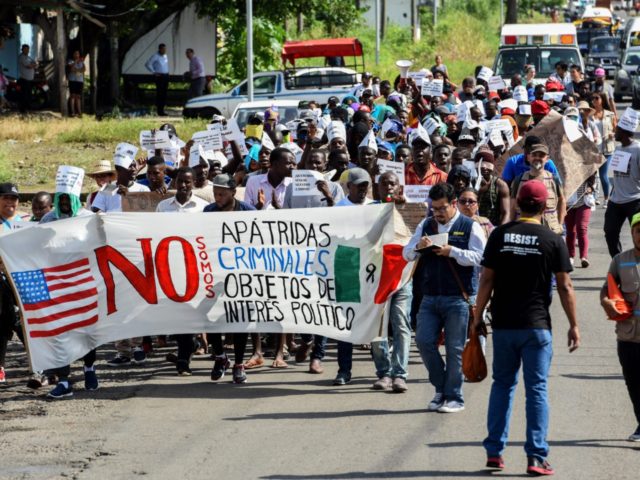Mexican officials suggested Tuesday’s migration talks in the White House were acrimonious, but U.S. leaders portrayed the talks as a success.
“The leaders agreed that while progress has been made, more work remains in order to further reduce the flow of illegal migrants to the United States,” said an official readout statement released by the White House.
The statement added, “the leaders agreed to implement the Migrant Protection Protocols to the fullest extent possible.”
The MPP protocols — also called “Remain in Mexico” — have allowed U.S. officials to return more than 42,000 migrants back to Mexico before their asylum hearing in the United States. The returns mean the migrants are not released into the United States to get jobs or to give birth to U.S.-citizen children.
Mexico’s foreign minister chose to publicly highlight the two countries’ differences by denouncing a prior proposal that U.S. officials have not recently demanded in public. That proposal was to have Mexico sign a “Safe Third Country” agreement that would make it responsible for all migrants who crossed through the country on the way to the U.S. border.
In June, the Mexican government persuaded Trump they would block the migration without having to sign a “Safe Third” deal.
By subscribing, you agree to our terms of use & privacy policy. You will receive email marketing messages from Breitbart News Network to the email you provide. You may unsubscribe at any time.
“Mexico is not and will not accept being a ‘Safe Third Country,'” Marcelo Ebrard, Mexico’s minister of foreign affairs, announced the day before the talks. He also touted Mexico’s crackdown which has reduced migrant arrivals at the U.S. border from 143,000 in May to just 64,600 in August.
The migration reductions achieved since June are “irreversible,” Ebrard said in a press conference after his meetings with Vice President Mike Pence and President Donald Trump.
Notably, Ebrard did not denounce the Remain in Mexico program, which has the potential wreck the cartel’s labor-trafficking business into the United States.
The program would wreck the trafficking by preventing migrants from getting U.S. jobs while they wait for two or more years to have their asylum claim heard by a judge. Without those jobs, the migrants cannot repay the cartel-linked coyotes for the cost of smuggling them through Mexico — so wrecking the economic incentive for the cartels to run labor-trafficking networks.
The evidence of closed door cooperation was highlighted by the fact the Mexicans also won a concession from the United States — a new project to curb the flow of U.S. guns to the drug cartels in Mexico. “I am sure we will freeze the illicit arms traffic. The time has come. Thank you!!,” Ebrard tweeted after the meeting.
The meeting suggests Mexico will continue to block the migration, said José Díaz-Briseño, a D.C.-based correspondent for the Mexican magazine, @Reforma. He said:
Main take from today’s US/MX migration meeting: Post-June 8th phase of increased US/Mexico enforcement seems to be here to stay (for at least a while) with 25k permanent Mexican troops devoted to the border mission + expanded MPP returns to Mexico’s border cities
Since June, the Mexican government has reduced migration through Mexico by 60 percent, partly because polls show Mexico’s public increasingly opposes the turbulent migration of Central Americans, Africans, and Asians through their nation.
In the Tuesday meeting, Secretary of State Mike Pompeo said the administration is “deeply appreciative” pf Mexico’s efforts.
The praise makes some sense for the department, which is also working with Mexico to win approvals of the NAFTA 2 treaty in Mexico, Canada, and the United States. The new treaty is titled “the United States-Mexico-Canada Agreement,” or USMCA.
But officials at the Department of Homeland Security were less diplomatic.
Mexican officials are “stepping up in unprecedented ways, but we need them to continue to sustain that, and we need them to continue to do more,” said Mark Morgan, the acting commissioner of the U.S. Customs and Border Protection agency.
“We need them to continue to join and expand the MPP, which is a gamechanger …. to share intelligence and develop targeted enforcement actions at strategic locations … we need them to continue to do more,” he told journalists at a Sept. 9 press conference in the White House.
The continued dispute with Mexico is also part of a larger campaign to persuade officials in Latin American countries to adopt stricter curbs against migration.
The U.S. is offering sticks and carrots, including federal financing for a huge new electricity generation station in El Salvador, which is to be fuelled by U.S. exports of natural gas.
The other carrots include increased trade with the United States. That promise is being helped by tariffs on Chinese exports which are pressuring investors to move factories to other countries, including Mexico and the Latin American countries.
The United States is also offering U.S.-aided upgrades to the trade and customs procedures in Latin American countries. The changes are needed because the nations’ established rules make it difficult for Latin American factories to quickly export textiles and other goods to foreign customers.
But Mexican and Latin American officials do not want to be pushed around — and really do not want to be seen being pushed around – by the hugely powerful United States.
Mexico is opposing a “Safe Third Country” agreement that would allow the United States to reject any asylum requests from people who crossed Mexico to reach the United States. Under international law, a “Safe Third” agreement with Mexico gives it the duty of accepting asylum requests. In May and June, U.S. officials pushed for a Safe Third deal with Mexico, but Mexico instead promised to crack down on organized migrant-smuggling and labor-trafficking through the United States.
The governments of Guatemala and Honduras are also opposing U.S. pressure to accept “Safe Third” deals, complete with the responsibility to handle migrants.
In response, U.S. officials have stopped using the “Safe Third” language, and are describing draft agreements as migration cooperation agreements.



COMMENTS
Please let us know if you're having issues with commenting.